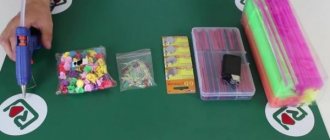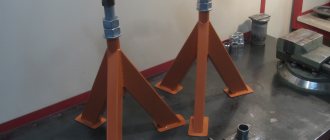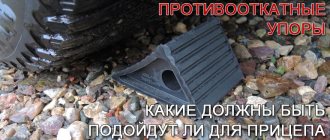01/19/2022 9 187 Light and sound devices
Author: Ivan Baranov
Sometimes drivers, especially beginners, forget to turn off the turn signal after completing a maneuver. The standard clicks are sometimes not audible if the music is playing loudly. An audible 12 v turn signal, made by yourself, will help correct the situation. Instructions for making your own tweeter are included in this article.
[Hide]
Sound doubler for direction indicator - diagram
Nowadays, modern cars are equipped with direction indicators that automatically return to their original position when the maneuver is completed.
But this does not apply to all models, and there is no need to talk about budget and old cars. We have all seen moving vehicles on the roads with their turn signals on, when the driver simply forgot to turn them off.
This especially affects novice car enthusiasts. This will greatly disorient other road users and may lead to an emergency.
The sound of the turn signal - a sound backup - will help you avoid such an unpleasant situation. The circuit and design of such a device will be discussed in today’s article.
The device circuit is very simple. The idea is to connect a miniature board to the car's dashboard indicator lamps (+U1 and +U2). Essentially, when the turn signals are turned on, power supply is simply applied to the circuit.
The circuit itself is two generators connected in series. Each time the indicator is turned on, the circuit plays several intermittent sound signals. The number of beeps each time the pointer is turned on, as well as their tone, can be configured.
So, we have two generators DD1.1, DD1.2 - the number of sound signals when the indicator is lit and DD1.3, DD1.4 - the tone of the reproduced sound vibrations. The first generator controls the start of the second, i.e. the generator on DD1.3, DD1.4 works only when the first one works.
The frequency with which the generators operate is determined by the parameters of their RC circuits: R1C1 and R2C2. This is what setting up the circuit is all about. By selecting capacitor C1 you can regulate the number of sound vibrations, and by selecting C2 you can regulate their fundamental tone.
Almost any buzzer (piezo emitter) designed for a voltage of 12 V without a built-in generator can be used. For example, such as HCM1212A or HCM1612A.
Printed circuit board (link) - single-sided for installing SMD components. DD1 chip in SO-14 package, resistors and capacitors in 1206 packages. You can use any diodes of suitable size, for example, DL4148.
Contact pads: +U1 and +U2 - connection to the pointer indicator lights, GND - ground, BZ1 - connection to the piezo emitter.
I know that many people do not like surface mounting or are simply “unfriendly” with it. This is also not a problem. In general, everything can be done by hanging installation, the main thing is that there is somewhere to place it all later. The DD1 microcircuit is replaceable with our K561LA7 with the same pinout, the resistors are ordinary MLT, and the capacitors are K10-17.
Source of the article: https://xn--100—j4dau4ec0ao.xn--p1ai/zvukovoj-dublyor-ukazatelya-povorotov-sxema/
Purpose of the sound turn signal repeater
In cars, as a rule, turn signal switches began to be installed, which automatically return to the neutral position after completing the maneuver. This has its advantages: there is no need to be distracted by turning off the turn signals when the turn is completed, and there is no need to waste time checking whether the signal is turned off. Over time, the auto-return switch may fail (video author: Alexander Baranov).
On some vehicles, the switch does not automatically return to its original position. In this case, you must independently ensure that it turns off after completing the turn. Clicks are heard, but sometimes you can’t hear them due to loud music or noise.
If you do not turn off your turn signals in time, this may cause an emergency on the road, as it confuses other road users.
By installing an audible warning of the switch relay operation, you can solve the problem of forgetting to turn off the turns.
Making a car craft - making an audible turn signal for your “Swallow”
Sometimes drivers, especially beginners, forget to turn off the turn signal after completing a maneuver. The standard clicks are sometimes not audible if the music is playing loudly. An audible 12 v turn signal, made by yourself, will help correct the situation. Instructions for making your own tweeter are included in this article.
Instructions for making a beeper for turn signals
You can make an audible turn signal for your car with your own hands within 15 minutes, without contacting a car service about it. To create such a duplicate turn signal, you will need a K561LN2 microcircuit; it will serve as the basis. In addition, you need a buzzer, but without a built-in generator.
Universal audio repeater
You can take a buzzer that has a built-in generator if you like its sound. In this case, we look at an example of connecting a buzzer to a standard low-frequency generator. Having connected to the bass generator, you should turn the tuning knob and select the most suitable sound. Now you can reproduce it using the K561LN2 microcircuit and a generator as a basis.
Tweeter connection diagram
The device diagram can be represented in two parts:
- The generator is assembled from two logic elements INV1 and INV2, to which a timing RC circuit is connected.
- The amplifier consists of three logic elements INV3, INV4, INV5 paralleled with each other. They are connected in parallel to amplify the switched current. Thanks to the amplifier, the generator can operate with a load in the form of a boomer.
The tone of the audio repeater is adjusted by changing the value of C1 and R1. When connecting the device, the negative pole is attached to the vehicle ground, and the positive pole is taken from the emergency stop button through “decoupling” diodes.
To determine the button terminals, you should use a multimeter. On it you need to select the mode for measuring DC voltage. After turning on the left turn signal, you need to look at which terminal the +12 Volt voltage periodically appears. Similar actions must be performed by turning on the right turn signal.
Assembled audio device
In this case, the device is mounted mounted. For the housing of the sound turn signal, a 2 mm syringe with a piston removed from it is used. The wire comes out of a narrow hole - the nose of the syringe, and the buzzer is attached to the back of the syringe using hot-melt adhesive.
Thus, it is easy to assemble an audio turn signal repeater with your own hands using a microcircuit and 5 logic elements. At the same time, you can save time and money on visiting a car service center.
Homemade sound duplicator of turns on the K561ln2 chip
Novice motorists sometimes forget to turn off the turn signal after completing the maneuver, which can confuse other road users.
A homemade sound turn signal repeater, which you can make with your own hands in 10 minutes, can help in solving this issue. diagram of a homemade sound duplicator (repeater) of rotation on a k561ln2 microcircuit and a “boozer” without a built-in generator
will come to the aid of lovers of homemade products for cars I’ll tell you right away why I didn’t use a regular buzzer with a built-in generator - I didn’t like the sound tone. Therefore, I first connected the buzzer to an existing low-frequency generator, turned the knob, chose the most pleasant sound and reproduced it using the generator on the k561ln2 chip.
The entire turn signal repeater circuit can be divided into 2 parts:
- The generator is made on 2 logical elements INV1 and INV2 as well as a time-setting RC circuit
- The amplifier is made of 3 logical elements INV3 INV4 INV5 connected in parallel in order to amplify the switched current. The amplifier allows the generator to operate with loads such as “buser”.
Frequency adjustment (adjusting the sound tone of the turn signal repeater) is done by changing the value of R1 and C1.
Installation and connection of the turn signal circuit to the on-board network.
The “-” circuit is connected to the vehicle ground, and the “+” is supplied through “decoupling” diodes from the emergency stop button. To determine which terminals of the button to connect to, take a multimeter, set it to DC voltage measurement mode, turn on the left turn - find at which terminal + 12V cyclically appears and disappears, do the same with the left turn turned on.
In my case, the circuit was assembled using the surface-mounted method. As a housing for the sound duplicator of turns, a 2-ml syringe was chosen from which the piston was removed. The wire was taken out of the spout hole, and the buzzer was glued with hot glue to the pad on the opposite side. As you can see, in 10 minutes you can make your own sound duplicator of turns using a logic chip and a pair of attachments
Samodelkin
I live in the World of DIY, I post articles sent by readers. Sometimes I write on topics: useful homemade products for the home and homemade products for radio amateurs.
New homemade products by Samodelkin (See all)
samodelka.info
Do It Yourself (Ogonyok) 1998-04, page 53
SOUND
REPEATER-
ALARM
In the almanac “Do It Yourself” No. 2 for 1996, an article by S. Antoshkin “My Ar porridge” was published, dedicated to a homemade sound repeater for the light signal of the direction indicators in a car.
An audio repeater is a very useful and necessary thing, and I decided to make this simple device according to the diagram given in the article.
The assembled device did not work at first. Then I found the reason. An error crept into the illustration, which did not allow the assembled device to work. By the way, some other errors were also discovered. In particular, the phone's resistance cannot realistically range from 30 to 3000 ohms. In order for the sound to be heard, the resistance of the dynamic head must be about 50 ohms. With a higher head resistance, the sound simply will not be heard, and with a lower resistance, the transistor current will exceed its permissible maximum current.
The signaling device, the modified diagram of which is shown in Fig. 1, is an asymmetrical multivibrator (the convenience of this circuit is determined by the use of transistors of different structures, which allows you to do without many parts).
Oscillations in the circuit arise due to positive feedback between the transi collector
following the published
side VT2 and the base of transistor VT1 through capacitor C1.
The following elements are used in the circuit: transistor VT1 type MP42, transistor VT2 type MP38, resistor R1 type MJ1T 0.25 with a nominal value of 4.7 kOhm, capacitor C1 type MBM with a nominal value of 4700 pF, telephone BF1 brand N63K (from a telephone set) with a resistance of 56 Ohms .
Assembled according to the diagram shown in Fig. 1, the sound repeater works fine, but it has some drawback - the repeater starts beeping immediately after turning on the turn signal. And this is not very convenient, since in practice there are often cases
Source of the article: https://zhurnalko.net/=sam/sdelaj-sam_ogonek/1998-04—num53
DIY sound piezo emitter | DIY master class
The circuit presented in this article is very easy to repeat and should not cause any difficulties in assembly. It can be used in various devices for sound notification. For example, an alarm system, sound duplication of a turn signal in a car or bicycle, a low battery signal, and so on. You can, of course, take a ready-made beeper, for example, from an old Chinese alarm clock, musical card or other devices, but I decided to make it myself with my own hands. It's more interesting that way. Another goal of the assembly is to popularize youth’s passion for radio electronics. If this site can captivate at least a few people with such an interesting and good cause, then its task can be considered completed. I took a simple, but proven scheme. I don’t even remember where I got it from.
Piezo sound emitter circuit
Parts for assembling the horn circuit
Parts for the circuit can be used in a very wide range. For example, La7 microcircuits from the K176, K164, K564, K561 or K561LE5 series or imported analogues. In order not to solder and desolder the microcircuit, it is best to take a special contact pad and solder it into the circuit (it costs pennies), and replacing the microcircuit will take seconds, and during soldering there is no risk that the microcircuit will overheat or be damaged by static electricity. In addition, you can easily test different brands of microcircuits for performance. Capacitor C1 is polar with a voltage of at least 15 volts and a capacity of 47 to 500 microfarads. If you want the buzzer to immediately stop after turning off the power, then this capacitor must be excluded, otherwise after turning off the power, the sound continues until the capacitor is discharged. Ceramic capacitor C2 from 0.1 to 0.47 microfarads. They are indicated by numbers on the cover - 104, 154, 224, 474. Resistor R1 from 5 to 50 kilo Ohms. Any power, but less is better. So that the dimensions are not large. Potentiometer R2 from 68 to 500 kilo Ohms. The power is the same, less. You can use any diode you like. It is used to protect the chip from improper power connections. You can do without it altogether.
Sound emitter ZP-3 or any similar.
How to connect ZP-3? If the ZP-3 sound emitter is new, then you need to solder wires to it, as in the photo. Soldering is easy if you use flux. We solder one wire to the membrane. Solder the second wire to either of the two terminals. The supply voltage of the circuit is 12 volts. This could be a battery, rectifier or any other DC source. The sound tone of the device depends on the values of the circuit elements, so you can experiment by changing capacitors and resistors to achieve a sound that you like. In order not to make a printed circuit board, it is best to take and use a breadboard; it turns out much easier and faster.
With proper assembly and serviceable parts, the circuit starts working immediately and does not require adjustment. If you don’t like the tone, then adjust the potentiometer to your taste. The signaling device is assembled.
Watch the tests of the assembled buzzer in the video
sdelaysam-svoimirukami.ru
Sound turn signal
In order not to forget to turn off the turn or handbrake lever, I suggest adding a simple device to your car - a signaling device. The sound alarm is assembled on a common and inexpensive K155LA3 microcircuit. The signaling device is connected to the turn signal or handbrake warning lamp.
The circuit diagram of the alarm is shown below.
A high-tone generator is assembled on DD1.1-DD1.2, controlled by a low-tone generator assembled on DD1.3-DD1.4. The frequencies of the generators are selected by capacitors of 0.47 μF and 47 μF, respectively.
A capacitor connected in parallel with the zener diode serves to dampen the generator and can be excluded from the circuit.
The circuit is assembled on a small PCB board. The housing can be two screens from inductors from old tube TVs.
The alarm can be installed in the instrument panel, where it is connected to the warning lamp.
A. Zotov, Volgograd region.
SHARE WITH YOUR FRIENDS
Combined, electronic direction indicator with sound signal
Hi all! An article on the design of an electronic turn signal, as well as the design of their sound double, has already been published on the site. In total, we get two independent electronic circuits,
but it would be logical to combine these two designs into one scheme, thereby simplifying the final product. It is precisely this device that will be discussed in today’s article.
To increase the reliability and stability of operation, the electronic turn signal circuit is made not on a multivibrator with a master RC circuit, as in most similar designs, but on a specialized IL33193 microcircuit; you can read about its operation, operating principle and typical switching circuits in the datasheet.
The DA1 chip is a new generation of specialized industrial switches for direction indicators. It has a low current consumption in standby mode, which allows you to reduce the load on the battery to the minimum possible and works with a low resistance of the R11 shunt to determine the malfunction of the turn signal lamps.
The p-mosfet transistor IRF4905PBF in a TO-220 package is used as a power switch in the circuit. The resistance of its channel in the open state is 0.02 Ohm, which made it possible to dispense with the use of a heat sink even when operating at a load of 100 W (emergency operating mode using incandescent lamps).
The sound circuit during operation of the power switch VT4 is made on two transistors VT1 and VT3. This generator allows you to get a characteristic sound signal on the buzzer (piezo emitter) BA1HCM1612A, reminiscent of the operation of a regular standard electromechanical relay. But the tone of the signal has additional color and is more pleasant to the ear.
The printed circuit board is made of single-sided foil fiberglass. The design uses resistors C2-23, permanent capacitors K10-17B, electrolytic capacitors - ECAP. Instead of transistors VT2 and VT3, you can use our KT3117A, and instead of VT1 - KT502. Shunt - resistor R11 - a piece of copper winding wire 3 cm long and 0.8 mm in diameter.
I do not recommend changing the VT4 key power transistor to another. Buzzer BA1 is soldered directly onto the PCB. I also do not recommend replacing it with another model, since this changes the character and final tone of the soundtrack.
You can watch a video demonstrating the operation of one of the turn signal options assembled according to this scheme below.
Source
Top 10 articles
- A simple and reliable DIY metal detector - 208,856 views.
- DIY microwave oven repair - 194,941 views.
- Charger from a computer power supply. — 191,247 views.
- Simple DIY metal detector - 187,152 views.
- Car chargers. Scheme. Principle of operation. — 166,723 views.
- A simple and reliable thermostat circuit for an incubator - 157,938 views.
- A variety of simple circuits on the NE555 - 125,104 views.
- Simple automatic charger - 123,237 views.
- DIY moonshine still - 111,303 views.
- Simple pulse metal detector "PIRAT" - 106,764 views.
Translator
We are in social networks:
Subscribe RSS
Subscribe to our RSS feed to receive site news. Stay connected!
Briefly about the site:
Master Vintik. Everything with your own hands!
— this is a site for those who like to make, repair, and create with their own hands! Here you will find free reference books and programs. The site contains simple diagrams, as well as tips for DIY beginners. Some of the repair schemes and methods were developed by the authors and friends of the site. The rest of the material is taken from open sources and is used for informational purposes only.
Do you like to tinker and make crafts? Send photos and descriptions to our website by email
or through the form.
Programs, diagrams and literature - all FREE!
If you like the site, add it to your favorites (press Ctrl + D)
, and you can also subscribe to RSS news and always receive new articles on the feed. If you have a question about a pattern or craft? Welcome to our forum! We are always happy to provide assistance in setting up circuits, making repairs, and making crafts!
Source of the article: https://www.mastervintik.ru/zvukovoj-signalizator-povorotov/











